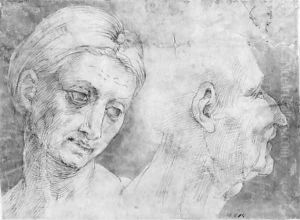Bartolomeo Bandinelli Paintings
Bartolomeo Bandinelli, also known as Baccio Bandinelli or Bartolommeo Brandini, was an Italian sculptor, draughtsman, and painter who was born in Florence, Italy in 1493. He was a prominent figure during the High Renaissance and is best known for his monumental sculptures in marble. Bandinelli came from a family of goldsmiths and sculptors, and his father, Michelangelo di Viviano dei Bandinelli, ensured that Bartolomeo received a comprehensive artistic training.
Bandinelli's early work was heavily influenced by his study of the sculptures of Michelangelo and the paintings of Raphael. His early promise was recognized by patrons such as the Medici family, who were the rulers of Florence at the time. His first major commission was the colossal marble group 'Hercules and Cacus' (1534) for the Piazza della Signoria in Florence, placed opposite Michelangelo's David. This work, however, was met with mixed criticism, with some contemporaries unfavorably comparing it to Michelangelo's masterpiece.
Despite the criticism, Bandinelli's reputation as a sculptor was such that he was commissioned to complete several important works, including the 'Pietà' in the Museo dell'Opera del Duomo, Florence, and the marble figure of 'Adam' for the tomb of Pope Clement VII in Santa Maria sopra Minerva, Rome. His style was characterized by a focus on muscular anatomy and a tendency towards exaggerated poses, which some critics viewed as lacking the grace and proportion found in the work of his contemporaries.
Bandinelli's influence extended to his role as a teacher, as he opened a prominent art school in Florence which attracted many pupils. His drawings, which were highly valued for their virtuosity, were also a significant part of his artistic output. They show his interest in human anatomy and his study of classical sculpture.
Bartolomeo Bandinelli's work was representative of the Mannerist style that was emerging in the later years of the High Renaissance, a style marked by artificiality and a departure from the harmonious ideals of the earlier Renaissance. His career was marked by both significant achievements and controversies, reflecting the competitive and often contentious art world of Renaissance Florence.
Bandinelli passed away in 1560 in Florence. Despite the mixed reception of some of his works during his lifetime, he remains an important figure in the history of Italian Renaissance art. His contributions to sculpture and his influence on the generation of artists that followed have secured his place in the annals of art history.
